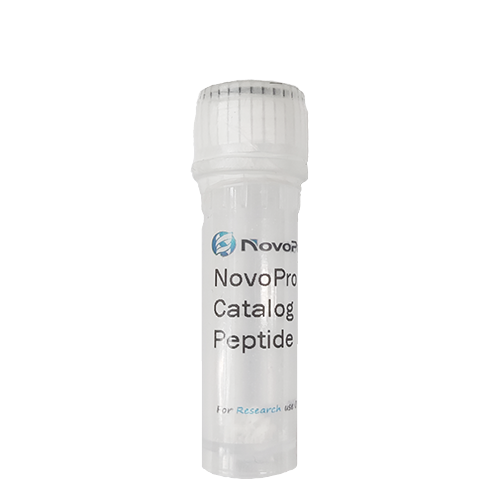BMP-7 (121-130) peptide
Not For Human Use, Lab Use Only.
Cat.#: 319734
Special Price 101.70 USD
-
Product Name
BMP-7 (121-130) peptide
-
Documents
Batch to batch variation of the purity
-
Sequence Shortening
H-SNVILKKYRN-OH
-
Sequence
H-Ser-Asn-Val-Ile-Leu-Lys-Lys-Tyr-Arg-Asn-OH
-
Length (aa)
10
-
Peptide Purity (HPLC)
95.59%
-
Molecular Formula
C55H95N17O15
-
Molecular Weight
1234.44
-
Source
Synthetic
-
Form
Powder
-
Description
SNVILKKYRN peptide is derived from bone morphogenetic protein-7 (BMP-7). When combined with KPSSAPTQLN, it enhances osteoblast density.
-
Storage Guidelines
Normally, this peptide will be delivered in lyophilized form and should be stored in a freezer at or below -20 °C. For more details, please refer to the manual: Handling and Storage of Synthetic Peptides
-
References
- Chen Y, Webster TJ. Increased osteoblast functions in the presence of BMP-7 short peptides for nanostructured biomaterial applications. J Biomed Mater Res A. 2009 Oct;91(1):296-304. doi: 10.1002/jbm.a.32246. PMID: 18980196; PMCID: PMC2732755.
-
About TFA salt
Trifluoroacetic acid (TFA) is a common counterion from the purification process using High-Performance Liquid Chromatography (HPLC). The presence of TFA can affect the peptide's net weight, appearance, and solubility.
Impact on Net Weight: The TFA salt contributes to the total mass of the product. In most cases, the peptide content constitutes >80% of the total weight, with TFA accounting for the remainder.
Solubility: TFA salts generally enhance the solubility of peptides in aqueous solutions.
In Biological Assays: For most standard in vitro assays, the residual TFA levels do not cause interference. However, for highly sensitive cellular or biochemical studies, please be aware of its presence.
-
Molar Concentration Calculator
-
Dilution Calculator
-
Percent Concentration Calculator
Mass (g) = Concentration (mol/L) × Volume (L) × Molecular Weight (g/mol)
Related Products / Services
• Peptide Services: NovoPro's peptide synthesis services include standard chemical peptide synthesis, peptide modification, peptide libraries, and recombinant peptide expression.
• Standard Peptide Synthesis: NovoPro offers quality peptides at the most competitive prices in the industry, starting at $3.20 per amino acid. NovoPro provides PepBox – Automatic Quote Tool for online price calculation.
• Peptide Modifications: NovoPro offers a wide range of peptide modification services including isotope labeling (2H, 15N, and 13C), multiple disulfide bonds, multiple phosphorylations, KLH, BSA, ovalbumin, amidation, acetylation, biotin, FITC, etc.
Please note: All products are "FOR RESEARCH USE ONLY AND ARE NOT INTENDED FOR DIAGNOSTIC OR THERAPEUTIC USE"

